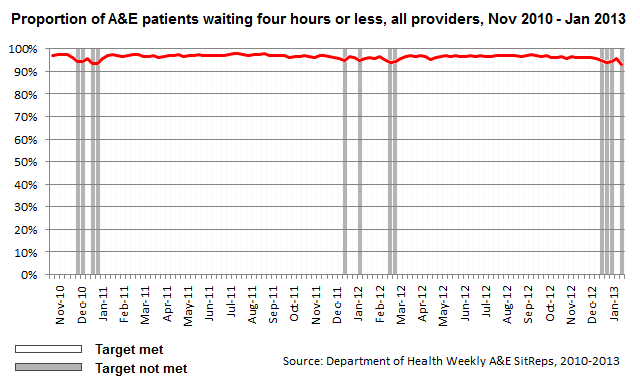Accident or emergency? Has the NHS failed to hit the A&E waiting time target for 6 months?
"NHS fails to hit A&E target every week for six months... In the last six months, an extra 107,000 patients have had to wait beyond the four-hour target time compared to the same period last year."
Labour Party, 2 April 2013
In January, Full Fact asked whether Accident and Emergency waiting times were an accident waiting to happen for the Government. At the time, Labour claimed the Coalition were presiding over a prolonged period of missed waiting time targets for major A&E departments (that is, departments with a 24-hour consultant-led service as opposed to minor walk-in centres).
This was correct, although not hugely significant. The picture was more positive if we also looked at minor A&E facilities, and it was difficult to discern any meaningful trend in waiting times since 2010 anyway, beyond the usual seasonal variations (we normally expect longer waiting times in the winter months).
But that's not to say the issue of people waiting for prolonged periods isn't an important one. Earlier this week, Labour circulated a poster on social media and a press release on their website hitting out at the Government's record of missing targets.
Targets missed every week for six months?
Against the target of seeing 95% of patients within four hours (that's from arrival to admission, transfer to another organisation, or discharge), the Government have missed this target for all A&E departments for the past nine weeks running, and have been mostly missing the target since December last year.
This graph from a recent factcheck demonstrates some of the recent targets met and missed up to January this year (with targets having mostly been missed since then). The winter seasonality in the figures is apparent just by glancing at the trend over time:

This is worse than last year, when only a handful of weeks fell below the standard. However, we also need to remember that during the winter months waiting times tend to be longer (and as many readers don't need to be told, this year's winter has been an especially long one).
For major A&Es, the Government has indeed missed the 95% mark for 26 consecutive weeks.
107,000 patients waiting, or 107,000 more patients waiting?
Labour's poster and press release actually say quite different things. The poster simply puts a number on the volume of patients waiting more than four hours, while the press release claims that this figure represents the number of extra patients waiting this long in addition to the number of patients that were trapped in A&Es for longer than four hours in the same period last year. Which is accurate?
After Full Fact got in touch, the Labour press office resolved some of the confusion: Labour claims that the poster is wrong and the press release is correct.
The latest weekly statistics from the Commissioning Board tell us that for the last 26 weeks, 539,000 patients waited more than four hours in A&E. In other words, Labour's poster understates its case by missing out 430,000 people.
It's more likely that the party intended for the wording of its press release to go viral, rather than the erroneous poster.
For the same 26 weeks last year (from September 2011 to March 2012), 421,000 patients waited more than four hours. That gives us about 118,000 more people waiting more than four hours compared to this period last year. It's unclear how Labour found 107,000, but in any case the point that many more people are now waiting beyond four hours stands.
In percentage terms, the changes look far smaller. For the last six months an average of 95% of patients have waited less than four hours, compared to 96% in the same six months last year.
Should we be worried?
It's correct that the number of patients waiting for longer than the four hour mark is much higher this winter than last, although the proportion of patients seen within the target time isn't hugely different.
We should also be wary about drawing conclusions from the data alone, as factors such as the weather may be playing some part in the recent spate of poor performances. Since the Coalition came to office in 2010, the overall trend in the proportion of patients seen within the target time has remained largely flat. Time will tell, however, if the recent trend in performance continues.